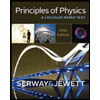As a protest against the umpire's calls, a baseball pitcher throws a ball straight up into the air at a speed of 17.0 m/s. In the process, he moves his hand through a distance of 1.45 m. If the ball has a mass of 0.150 kg, find the force he exerts on the ball to give it this upward speed.N
As a protest against the umpire's calls, a baseball pitcher throws a ball straight up into the air at a speed of 17.0 m/s. In the process, he moves his hand through a distance of 1.45 m. If the ball has a mass of 0.150 kg, find the force he exerts on the ball to give it this upward speed.N
University Physics Volume 1
18th Edition
ISBN:9781938168277
Author:William Moebs, Samuel J. Ling, Jeff Sanny
Publisher:William Moebs, Samuel J. Ling, Jeff Sanny
Chapter5: Newton's Law Of Motion
Section: Chapter Questions
Problem 77AP: (a) Find an equation to determine the magnitude of the net force required to stop a car of mass m,...
Related questions
Question
As a protest against the umpire's calls, a baseball pitcher throws a ball straight up into the air at a speed of 17.0 m/s. In the process, he moves his hand through a distance of 1.45 m. If the ball has a mass of 0.150 kg, find the force he exerts on the ball to give it this upward speed.
N
Expert Solution
This question has been solved!
Explore an expertly crafted, step-by-step solution for a thorough understanding of key concepts.
This is a popular solution!
Trending now
This is a popular solution!
Step by step
Solved in 3 steps with 1 images

Knowledge Booster
Learn more about
Need a deep-dive on the concept behind this application? Look no further. Learn more about this topic, physics and related others by exploring similar questions and additional content below.Recommended textbooks for you

University Physics Volume 1
Physics
ISBN:
9781938168277
Author:
William Moebs, Samuel J. Ling, Jeff Sanny
Publisher:
OpenStax - Rice University

Principles of Physics: A Calculus-Based Text
Physics
ISBN:
9781133104261
Author:
Raymond A. Serway, John W. Jewett
Publisher:
Cengage Learning

Physics for Scientists and Engineers: Foundations…
Physics
ISBN:
9781133939146
Author:
Katz, Debora M.
Publisher:
Cengage Learning

University Physics Volume 1
Physics
ISBN:
9781938168277
Author:
William Moebs, Samuel J. Ling, Jeff Sanny
Publisher:
OpenStax - Rice University

Principles of Physics: A Calculus-Based Text
Physics
ISBN:
9781133104261
Author:
Raymond A. Serway, John W. Jewett
Publisher:
Cengage Learning

Physics for Scientists and Engineers: Foundations…
Physics
ISBN:
9781133939146
Author:
Katz, Debora M.
Publisher:
Cengage Learning